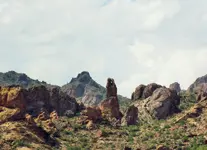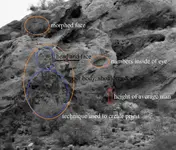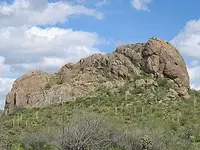I agree that existing natural formations were very likely used as landmarks for trails and other things. Its when people start claiming they were created by man that I tend to seek more evidence. And some of the claims made about natural formations tend to stretch the envelope of believability.
I agree.
However, on this very Website, I have seen photos (which I believe were unaltered, due to having some professional image editing experience myself) that are so obvious and recognizable, that they are extremely convincing as to being, large, complex, carefully man made works.
However, the same question is equally obvious---why would anyone spend so much time and effort, including the tremendous amount of logistics required for a special team of people skilled in this kind of fabrication, just to mark a location (or instructions to a treasure, if one even exists at these types of colossal monuments).
While just looking over many of these posted examples, and enjoying the sight of (what I assume to be) the works of men, the overall impression I ended up with was that there
was a story, of sorts, being told with them. But not necessarily of treasure or secrets of any kind.
It struck me that these appeared to be telling a story of people. Each group of monuments pictorially describing a regional group of people, and saying, "This is who we are, and what we do, and what our philosophy is. We are the people in this region. And you are now entering our territory.
As for how much time it would take to form this type of giant groups of monuments, I would say a lot of time. It would appear to me that these which I am talking about were made over very long periods, adding items or groups of items at
different times, as their culture expanded and changed.
The problem with this "hunch" (there isn't enough evidence to call it a theory), is that there is no "official" record of anyone being around, or having the necessary technology (even if somewhat primitive), where these monuments have been found, for such a long period as would allow for all this to fit into. I'm not referring specifically to the Superstitions, as these have been found in many other places, and very far apart at that---Although it seems that the farther apart, the more different is the story described by the giant monuments.
The only explanation for these (if they are in fact man made), considering the time frame and (what seems to me to be the) apparent purpose, would have the troubling consequence of being contradictory to Biblical History. And that is a huge problem, because it seems that official archeology has, as one of it's purposes, the job of trying to invalidate anything contradictory to Biblical History. Interestingly enough, this purpose has been in effect World wide, regardless of the popular religion of the area.
This has been shown time after time, when Out Of Place Artifacts have been found, and other contradicting archeological evidence has been discovered.
I wouldn't be surprised if some of this concerted false-invalidation is occurring about the Superstitions, as well.
My best advice to anyone would be to think for yourself!










